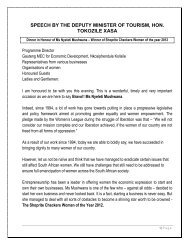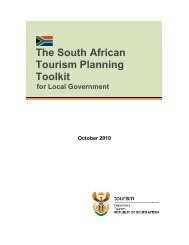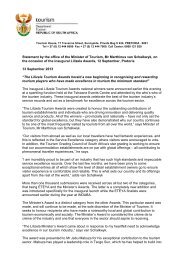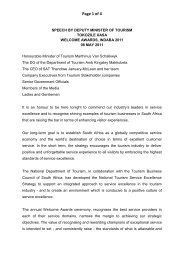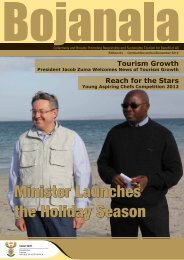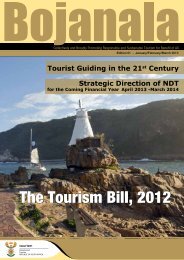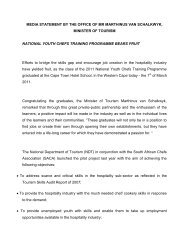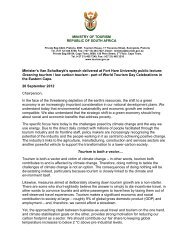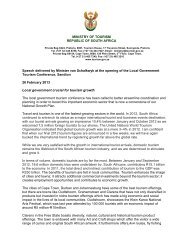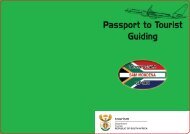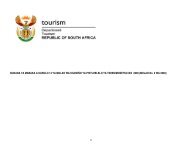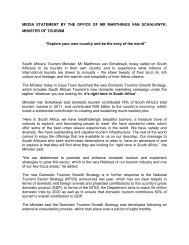tourism sector will be an increasingly important driver <strong>of</strong>competitiveness. Not only will industry in the near futurebe faced with the changing preferences <strong>of</strong> consumerswho want to travel responsibly, as well as increasedshareholder activism, but, from government’s side, theycan also expect a much tighter regulatory framework onissues <strong>of</strong> the green economy.In this regard, the World Travel and <strong>Tourism</strong> Council(WTTC) has already committed to a 50% reductionin CO2 emissions by 2035. The aviation sector[International Air Transport Association (IATA)] aims for a1,5% improvement in fuel efficiency per year up to 2020;carbon-neutral growth or a cap on emissions from 2020,and net carbon emissions <strong>of</strong> 50% below those <strong>of</strong> 2005by 2050.The shift to low-carbon cities presents many indirectopportunities in providing the required innovation,technology deployment and new market <strong>of</strong>feringson the adaptation and mitigation sides – not least for‘green’ entrepreneurs, ‘green’ work forces and decent‘green’ work, and ‘green’ investment in tourism-relatedinfrastructure, such as hotels, land transport, airports andconservation assets. Moreover, particular opportunitiesin the tourism sector include green building designand sustainable land transport, the energy-efficiencyretr<strong>of</strong>itting <strong>of</strong> accommodation establishments andother hospitality infrastructure, and the enhanced rollout<strong>of</strong> renewable energy sources and improved wastemanagement.Market trends that are affecting the tourism industryinclude demographics and lifestyle changes (e.g.ageing travellers, more young people travelling andreduced leisure time). More people are interested in‘volunteering’ (combining unique travel opportunities withmeaningful volunteer work); gap years are not only takenby the youth, and travellers are looking for authentic andniche experiences, among other trends. The demand formass-based leisure tourism is being replaced by a desireto connect emotionally with destinations, local peopleand local cultures.Price-conscious customers in traditional sourcemarkets are retiring later, are travelling for shorter periods,are spending less, and are taking trips closer to home.At the same time, the ageing baby-boomer market <strong>of</strong>Europe and America are moving into a consolidationphase <strong>of</strong> their lives, and their travel preferences arematuring. The general trend is for travellers to book laterand to keep their options open until as late as possiblein order to obtain better deals. In response to themore value-oriented mindset, various destinations aredeveloping innovative travel packages and new productsto attract customers. An appropriate response to thesetrends will therefore ensure the resilience <strong>of</strong> the industryin the long term.The recent global financial crisis has fundamentallychanged the economic and consumer landscape fortourism. Traditional source markets are showing a declinein outbound travel, and demand in the Western worldremains weak. The European Union’s working populationis declining, as is Japan’s. At an average <strong>of</strong> 6% economicgrowth, China, India and other emerging markets areexpected to recover faster than traditional sourcemarkets. The growing middle-income countries willbecome the leading outbound markets <strong>of</strong> the future. Thisdoes not render the traditional markets insignificant, andincome per capita in these markets will still overshadowthose in the emerging markets. However, overall, thelong-term opportunity lies in the fact that the middle classwill increasingly be found in China, India, Africa and LatinAmerica, and that the share <strong>of</strong> discretionary spending andconsumption in these markets will increase dramatically.Thus, it is evident that the travel and tourism sectoris crisis-sensitive, but also responds well to signs<strong>of</strong> recovery. However, the UNWTO expects that theeconomic crisis will s<strong>of</strong>ten demand in the short term, butthat the tourism industry will bounce back and continueits growth path in line with the long-term arrivals growthforecast <strong>of</strong> 4% per annum. According to the WTTC 10 ,tourism’s contribution to GDP was expected to rise by2% in 2010, creating an extra 964 000 jobs worldwide.The WTTC further reported that the true value <strong>of</strong> thetourism industry accounted for 9,2% <strong>of</strong> global GDP, andcontributed USD5,8 trillion to the global economy. TheCouncil also forecast that the global travel and tourismeconomy will grow by 4,3% per year over the next tenyears, which will create an additional 66 million jobs by2020.10 Viewpoint newsletter. Winter 2010.5
1.2.2 South African contextSouth Africa has come a long way since its firstdemocratic elections in April 1994. The 15-year reviewrecently conducted by government indicates thatsignificant progress has been made in some areas,but that some challenges still remain. In general, thepopulation is satisfied with government’s performanceover the past 15 years.South Africa has managed to stabilise its macroeconomy,with interest rates declining, a less volatilerand, and domestic demand increasing as a result<strong>of</strong> a growing middle class. Despite these, there areconcerns in respect <strong>of</strong> the coordination and integration<strong>of</strong> economic policies (industrial, fiscal and monetary), andthe inclusion <strong>of</strong> the second economy in the mainstreamremains a challenge. Growth in spending is underpinnedby infrastructure investment, including investment in newtourism products and activities.After the 2009 elections, President Jacob Zuma’sgovernment has made significant changes in thegovernment ministries, including the establishment <strong>of</strong>a stand-alone Ministry <strong>of</strong> <strong>Tourism</strong>, which indicatesthat the tourism industry itself has grown in stature andis being taken seriously by government. Governmenthas to create sustainable jobs and ensure that the lack<strong>of</strong> wealth is addressed in all areas, particularly in ruralenvironments. Despite early expectations that SouthAfrica may be shielded from the worst <strong>of</strong> the globaleconomic crisis, the second quarter <strong>of</strong> 2009 was thesecond consecutive quarter <strong>of</strong> decline in the GDP, andresulted in the country <strong>of</strong>ficially being in a recession.However, since the third quarter <strong>of</strong> 2009, the country hasbeen on a recovery path, and the results from the thirdquarter <strong>of</strong> 2010 confirmed that the country is continuingon that path, with a marginal 2,6% growth in GDP quarteron quarter. 11The retail industry is said to be gaining momentumagainst the backdrop <strong>of</strong> economic recovery; 12 theproperty market has shown significant signs <strong>of</strong>recovery, and, according to the <strong>National</strong> Association <strong>of</strong>Automobile Manufacturers <strong>of</strong> South Africa (NAAMSA),new motor vehicle sales increased by 29,6% year onyear in December 2010. 13 Therefore, it is expected thatthe economy will stabilise the job market, and enablegovernment to stimulate employment opportunities andultimately eradicate poverty. Air transport is also a keyenabler for leisure and business tourism. The number<strong>of</strong> airlines <strong>of</strong>fering direct flights to South Africa declinedfrom 66 in 1998 to 53 in 2008, but the country has highload factors (>65%); total air passenger movementsare increasing rapidly, and South Africa boasts muchenhancedairport infrastructure.As indicated in the introduction, the tourism industryhas grown significantly since the 1994 elections (seeFigure 1 below). Over the years, the number <strong>of</strong> hotelsin key locations, such as Cape Town, Johannesburg,Pretoria and Durban, has increased to accommodatea growing number <strong>of</strong> travellers, and, in recent years,the growth in occupancy rates and average roomrates was robust. However, after the 2010 World Cup’sincreased infrastructure supply, the accommodationsector is facing challenges in terms <strong>of</strong> occupancy rates.Similarly, other country developments, such as theproperty boom after South Africa’s selection as host<strong>of</strong> the 2010 World Cup, imposed a significant burdenon electricity supply, resulting in power shortages andincreased prices.11 Statistics South Africa. Gross Domestic Product, Annual estimates2000–2009, Regional estimates 2000–2009, Third quarter: 2010.Statistical Release. November 2010.12 South African Retail Industry Forecast to 2013. October 2010.13 “New vehicle sales end 2010 with 29.6% hike”. Business Day. 10January 2011.6



